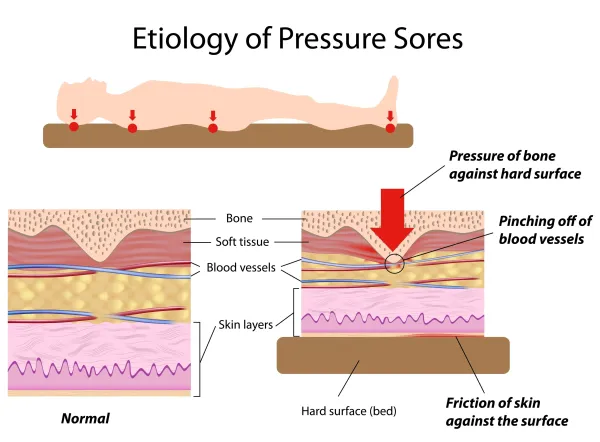Report One Code for Pressure Ulcer in 2014 With Specific Location Choices

Heads up: You’ll move from 14 code possibilities to more than 150.
Under the current version of ICD-9, you must report two codes for clear documentation of a pressure (decubitus) ulcer diagnosis under ICD-9 -- one code for the location, and the other to report the stage. All that changes when ICD-10 goes into effect.
Future: You’ll need just one code to report the pressure ulcer location and stage when ICD-10 goes into effect in October 2014. Your code options will explode, however, because you’ll shift from a current list of 14 code choices to more than 150 in ICD-10.
Step 1: Identify the Pressure Ulcer Site
With ICD-9, you have nine "location" codes to choose from for the ulcer site, as follows:
707.00 -- Pressure ulcer; unspecified site
707.01 -- … elbow
707.02 -- … upper back
707.03 -- … lower back
707.04 -- … hip
707.05 -- … buttock
707.06 -- … ankle
707.07 -- … heel
707.09 -- … other site.
ICD-10 provides much greater site specificity, creating many more code options. For example, your choices will include:
L89.9_ -- Pressure ulcer of unspecified site
L89.00_ -- Pressure ulcer of unspecified elbow
L89.01_ -- Pressure ulcer of right elbow
L89.02_ -- Pressure ulcer of left elbow
L89.10_ -- Pressure ulcer of unspecified part of back
L89.11_ -- Pressure ulcer of right upper back
L89.12_ -- Pressure ulcer of left upper back
L89.13_ -- Pressure ulcer of right lower back
L89.14_ -- Pressure ulcer of left lower back
L89.15_ -- Pressure ulcer of sacral region
L89.20_ -- Pressure ulcer of unspecified hip
L89.21_ -- Pressure ulcer of right hip
L89.22_ -- Pressure ulcer of left hip
L89.30_ -- Pressure ulcer of unspecified buttock
L89.31_ -- Pressure ulcer of right buttock
L89.32_ -- Pressure ulcer of left buttock
L89.4_ -- Pressure ulcer of contiguous site of back, buttock and hip
L89.50_ -- Pressure ulcer of unspecified ankle
L89.51_ -- Pressure ulcer of right ankle
L89.52_ -- Pressure ulcer of left ankle
L89.60_ -- Pressure ulcer of unspecified heel
L89.61_ -- Pressure ulcer of right heel
L89.62_ -- Pressure ulcer of left heel
L89.81_ -- Pressure ulcer of head
L89.89_ -- Pressure ulcer of other site.
Step 2: Choose the Pressure Ulcer Stage
If you look at the pressure ulcer site code 707.0x, ICD-9 includes a directive to "Use additional code to identify pressure ulcer stage (707.20-707.25)."
The current "stage" codes provide the following diagnostic information:
707.21 -- Pressure ulcer, stage I. This stage involves intact skin with redness of a localized area, usually over a bony prominence.
707.22 -- Pressure ulcer, stage II. Stage II ulcers may have intact or ruptured serum-filled blisters and a partial-thickness loss of dermis.
707.23 -- Pressure ulcer, stage III. Full-thickness tissue loss is characteristic of this stage, possibly with subcutaneous fat visible.
707.24 -- Pressure ulcer, stage IV. Exposed bone, tendon or muscle from full-thickness tissue loss defines this stage.
707.25 -- Pressure ulcer, unstageable. Report this code when the physician is unable to ascertain the ulcer’s stage or doesn’t document it well enough for coding purposes.
ICD-10 recognizes the same four stages -- plus two more for "unstageable" or "unspecified stage" pressure ulcers. Instead of using an additional code to capture the stage information, however, each of the site codes includes a final digit to account for these six "stage" choices.
For instance: L89.11_ expands to the following six codes:
L89.110 -- Pressure ulcer of right upper back, unstageable
L89.111 -- … stage 1
L89.112 -- … stage 2
L89.113 -- … stage 3
L89.114 -- … stage 4
L89.119 -- … unspecified stage.

